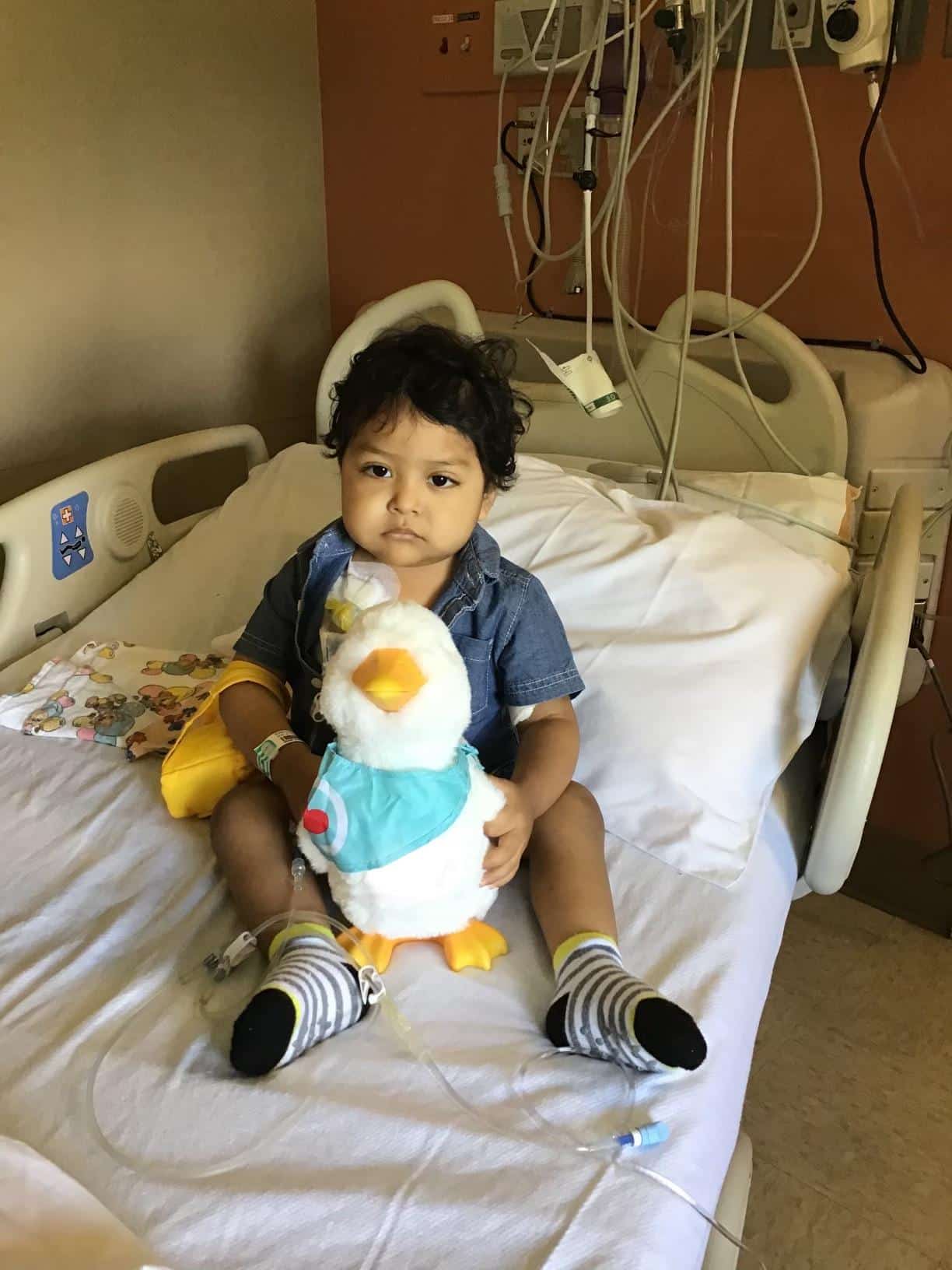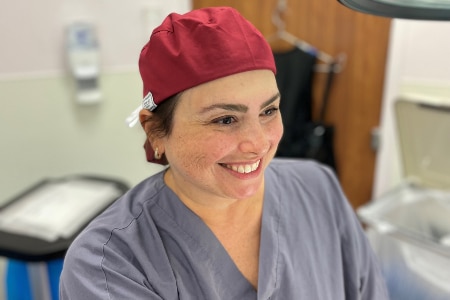Greenville, N.C. – ECU Health Medical Center recently earned accreditation from the Commission on Cancer (CoC), a quality program of the American College of Surgeons (ACS). This accreditation means patients will receive comprehensive, personalized care provided by a team of specialists working closely together, access to information on clinical trials and new treatment options, ongoing monitoring of care and lifelong follow-up, mental health support, financial guidance, survivorship care and other long-term services.
“I am proud of our ECU Health team members and physicians who work hard to provide the most advanced cancer care to eastern North Carolina,” said Brian Floyd, president of ECU Health Medical Center and chief operating officer of ECU Health. “Cancer is a terrible disease that has touched most, if not all, of us in some way. As a regional academic medical center, ECU Health Medical Center strives towards excellence in all it does. This accreditation is a testament to the tireless efforts of our cancer care teams, who make a difference in the lives of so many in our region.”

As a CoC-accredited cancer center, ECU Health Medical Center applies a multidisciplinary approach and treats cancer as a complex group of diseases that requires consultation among surgeons, medical and radiation oncologists, diagnostic radiologists, pathologists, and other health care professionals that specialize in caring for cancer patients. Cancer patients benefit from having access to clinical trials, screening and prevention events, palliative care, genetic counseling, rehabilitation, oncology nutrition, and survivorship services.
“Eastern North Carolina faces a disproportionately high rate of cancer, and as the largest health care provider in the East, ECU Health is committed to maintaining excellence in the delivery of comprehensive, compassionate, patient-centered, high-quality care for patients with all types of cancer,” said Dr. Darla Liles, Cancer Committee chair at ECU Health, professor and chief of the Division of Hematology and Oncology at the Brody School of Medicine at East Carolina University. “This accreditation demonstrates our holistic approach to cancer care that includes preventive measures, educational resources, clinical trials, support and survivorship services and treatment with the latest technologies and highest clinical standards.”
According to the American Cancer Society, more than 1.9 million new cancer cases and approximately 609,820 deaths from cancer are expected in 2023 in the United States. Of those, 67,690 new cases are expected in North Carolina. Residents in eastern North Carolina have access to ECU Health’s cancer care network that spans across nine hospitals – including the Eddie and Jo Allison Smith Tower at ECU Health Medical Center in Greenville that is home to both inpatient and outpatient cancer services – five radiation oncology sites, three joint ventures and numerous outpatient clinics.
“The Commission on Cancer brings together experts and advocates from across the country to develop standards for cancer care so that patients with cancer receive the highest quality care coordinated by a team of dedicated physicians and specialists,” said Timothy Wm. Mullett, MD, MBA, FACS, professor, general thoracic surgery medical director, Markey Cancer Center Affiliate and Research Networks University of Kentucky, and chair of the Commission on Cancer.
Greenville, N.C. – The National Accreditation Program for Breast Centers (NAPBC), a quality program administered by the American College of Surgeons, has granted accredited status to ECU Health Medical Center for the ninth year. Patients receiving care at a NAPBC-accredited center have access to information on clinical trials and new treatment options, genetic counseling, and patient-centered services including psychosocial support, rehabilitation services and survivorship care.
“ECU Health serves a vast rural region burdened by high prevalence of chronic diseases including cancer,” said Brian Floyd, chief operating officer of ECU Health and president of ECU Health Medical Center. “Our partnership with the Brody School of Medicine at East Carolina University allows us to provide research and clinical trials for patients, as well as recruit high-quality cancer care providers, both of which largely contribute to our accreditation. Bringing standardized, quality care close to home for the 1.4 million people we serve helps us meet our mission of improving the health and well-being of eastern North Carolina.”
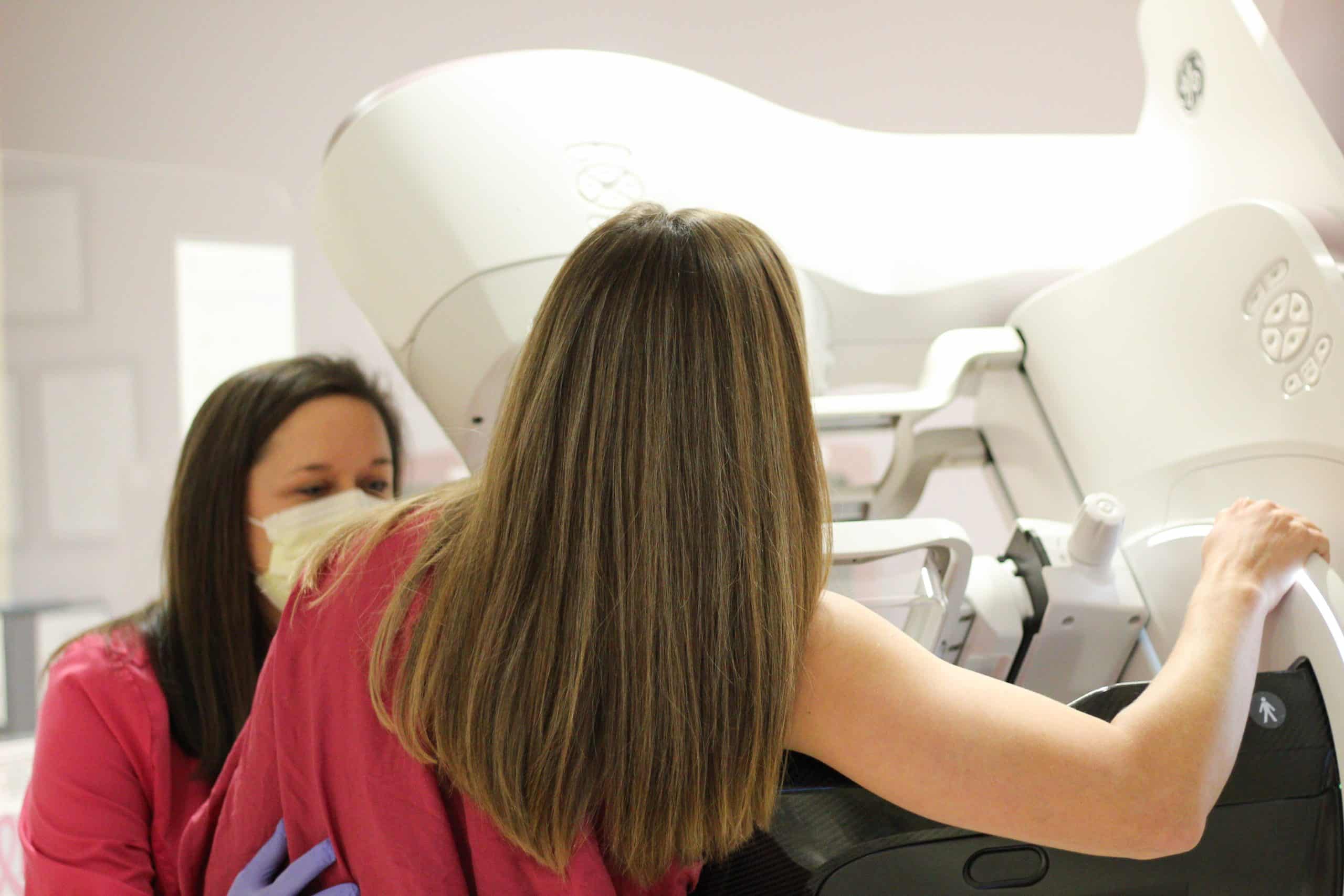
Breast cancer is the second leading cause of cancer deaths for women in North Carolina, according to the North Carolina Department of Health and Human Services. The even higher prevalence of cancers in eastern North Carolina highlights the importance of having an accredited cancer care center in the region. Access to preventative screenings and early detection allows for less invasive treatments, a greater variety of options and a greater potential to prevent the spread of breast cancer.
“ECU Health is committed to maintaining excellence in the delivery of comprehensive, compassionate, patient-centered, high-quality care for patients with all types of cancer,” said Dr. Emmanuel Zervos, executive director of cancer services at ECU Health, and professor at the Brody School of Medicine at ECU. “Patients with breast cancer at ECU Health benefit from a robust team of disease site specialists in surgery, oncology and radiotherapy who are committed to working together to provide the type of care this important designation represents. I am grateful to our ECU Health team members and new breast cancer program leader, Dr. Karinn Chambers, for not only adhering to these standards but surpassing them.”
Accreditation by NAPBC is granted to programs proven to provide the best possible care to patients with breast cancer. To achieve voluntary NAPBC accreditation, a breast center demonstrates compliance with the NAPBC standards that address a center’s leadership, clinical services, research, community outreach, professional education and quality improvement for patients. Breast centers seeking NAPBC accreditation undergo a site visit every three years.
To learn more about breast cancer screenings and treatment options near you, please visit ECUHealth.org/breast-cancer.
Learning your child is sick is devastating, in any language.
“He got sick when he was two years old,” Miguel Morales’ mother, Maria Martinez, said in Spanish. “His diagnosis was spelled LCH. It is one of the somewhat aggressive cancers. It was a very, very difficult process for him. Very painful for all of us to see my son suffer every day without being able to understand why he does not speak much.”
LCH, or Langerhans cell histiocytosis, is a rare form of cancer that most commonly appears in toddlers and children.
Complicating the diagnosis — the fact that English is a second language for Miguel, his mother Maria and their family.
“We take care of our patients that have are limited English speakers,” said Tania Elguezabal Christensen, Interpreter Services manager at ECU Health. “So we help them to navigate our health care system and we help them communicate with our providers, with our doctors and nurses about their health care.”
Tania and the Language Access Services team — which is comprised of interpreters and translators — help bridge an important gap for patients and families during a hospital stay. An integral part of a patient’s care team, they offer services for 240 languages and dialects across the ECU Health system.
“When we go to get medical treatment, we all want to understand what our diagnosis is and what the treatments are,” Elguezabal Christensen said. “When people don’t speak the language, it’s hard to understand all of that. That’s why it’s so important for us to be a conduit between patients and providers.”
Martinez said she was grateful for the assistance the Language Access Services team provided while her family navigated a challenging time.
“It was a very good thing for me,” Martinez said. “They have been very supportive during this long process with my son. They have helped me to better understand his situation, how to properly give the medications, and to clarify many doubts that I had with the doctors. Since I do not speak the language, they have been a very important source of support for me.”
One part of the journey that is easy to understand in any language, the milestone moment Miguel got to ring the bell at the James and Connie Maynard Children’s Hospital at ECU Health Medical Center. It’s a celebration of beating cancer, surrounded by the many teams who helped him along the way.
“For me it meant life, it meant opportunity, it meant opportunity to have my son with me,” Martinez said. “It meant everything. It meant that some of my worries about losing him were fading away. It meant that I could see him grow.”
Today, Miguel is a happy, typical 4-year-old boy. He loves to play and jump around, which was difficult for him to do while he was sick.
Martinez is grateful for the outcome — and for those who made it possible.
“Well, I thank everything, first to God and for giving us the opportunity to heal my son, to the entire doctor’s team, from interpreters, nurses, doctors, everyone who was there, the whole team because they really helped us a lot,” Martinez said.
Along with sharing her appreciation for her healthy son, Martinez also wants other parents to learn from her family’s experience.
“More what I would like to say is just my experience as a mother,” Martinez said. “I would tell people that are out there listening to me and mothers out there — ask questions. If someone tells you this is just an infection, keep digging and keep asking questions.”
Resources
A pink ribbon is one of the most recognizable symbols in health care. This is because breast cancer, the disease for which the color represents, is the second most common cancer in women, affecting one in eight women. Breast cancer develops when an abnormal growth occurs within the breast tissue, typically caused by uncontrolled cell growth in the breast. These rapidly growing cells form a potentially cancerous lump or mass and can spread to other areas, including lymph nodes.
Breast cancer often presents as:
- A lump or mass in the breast
- A change in size or shape of the breast
- A change in nipple appearance, including a newly inverted nipple or discharge
“I encourage everyone to know and understand what their breast tissue should look and feel like so they’re aware of any potential change,” said Dr. Karinn Chambers, breast surgical oncologist, ECU Health and ECU’s Brody School of Medicine.
It is never too early to begin self-exams of the breast, according to Dr. Chambers. However, women should begin breast cancer screenings annually at age 40, according to the American Cancer Society. This consists of a mammogram, which is an x-ray of the breast.
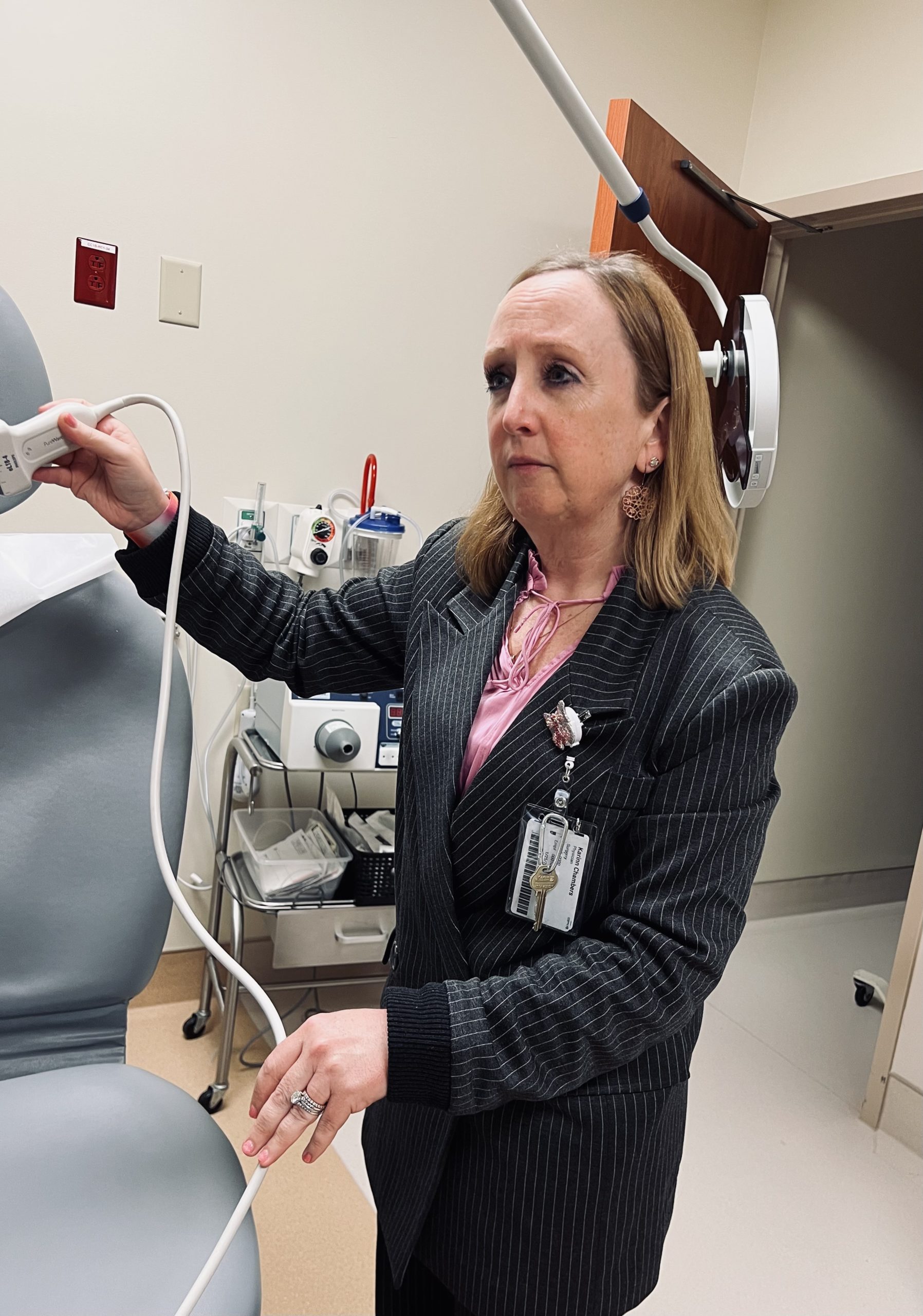
Dr. Chambers also emphasized that everyone, including men, should be aware of their breast health.
“Anyone can get breast cancer,” said Dr. Chambers. “I have seen breast cancer in people of different ages, the young and the elderly. Men can also get breast cancer.”
While breast cancer in men is much less common than in women, the American Cancer Society predicts that about 2,710 new cases of invasive breast cancer will be diagnosed in men in the United States in 2022.
“When a man is diagnosed with breast cancer, typically they present with the same symptoms as women – a new mass or lump within the breast,” said Dr. Chambers. “The causes and risk factors of breast cancer in men and women are also very similar.”
Breast cancer has both unknown and known risk factors. While experts still do not fully understand all of what causes breast cancer, genetics and lifestyle play a role in breast cancer.
“We recommend that women and men with a close family history of breast cancer undergo genetic testing to understand if they have a mutation on either the BRCA1 gene or the BRCA2 gene,” said Dr. Chambers. “BRCA1 and BRCA2 genes prevent proteins from rapidly growing out of control, which can cause certain cancers. For those who have the mutation, we do recommend prophylactic bilateral mastectomies, or removal of both breasts, as a preventative means to try to reduce their risk of breast cancer.”
While genetic risk factors are out of an individual’s control, there are behavioral changes one can make to lower their risk for breast cancer. The first is eating a healthy diet and exercising.
“Obesity is a big risk factor for breast cancer, and the rise of obesity in our population has led to an increased risk of breast cancer,” said Dr. Chambers. “Excess alcohol use can lead to increased risk of breast cancer as well.”
Experts highly encourage individuals to discuss screening with their primary care providers to understand their own risk for breast cancer based on their hormonal history, family history, health and age. The early detection of breast cancer allows for less invasive treatments, a greater variety of options and a greater potential to prevent the spread of breast cancer. When a person is unfortunately diagnosed with breast cancer, there are a variety of treatment options.
“The treatment of breast cancer consists of local tools and systemic tools,” said Dr. Chambers. “Local tools like surgery and radiation target the tumor directly. Systemic tools such as chemotherapy and hormone therapy can reach cancer throughout the body and may be used if the cancer has spread beyond the initial breast tissue.”
The bottom line?
“To prevent breast cancer, an individual should first discuss screening with their primary care providers so that they understand when and how often to get breast cancer screening,” said Dr. Chambers. “The second part of that would be to understand their own risk for breast cancer. Lastly, always remember to practice self-exams and know what is normal for your breasts. If you experience any changes, notify your primary care provider.”
Early diagnosis and a variety of treatment options have largely increased the odds of curing and managing breast cancer. ECU Health continues to offer 3D mammography at ten convenient locations throughout our region. Patients can take advantage of ECU Health’s free online risk assessment tool, talk with a provider and schedule a screening that meets their needs.
To learn more, please visit ECUHealth.org/breast-cancer.
It’s no secret prostate cancer is one of the most common cancers among men. In fact, nearly one in eight men will be diagnosed with prostate cancer in their lifetime. What many may not know is if caught early, prostate cancer can be easily treated and even cured. That’s why experts at ECU Health are urging men who have delayed getting a prostate cancer screening to return to their regular screenings to prevent advanced prostate cancer diagnoses.
The prostate, which only exists in men, is a walnut-sized gland tucked under the bladder and is involved in the reproductive process. The prostate can develop cancer and is one of the leading cancers diagnosed in men.
“We love to catch prostate cancer before there are any signs or symptoms. In order to do that, you need a blood test called a prostate-specific antigen, commonly known as a PSA blood test,” said Dr. Caroline Ames, ECU Health urologist. “Because the prostate is tucked up under the bladder, you may not have symptoms until it’s advanced.”
Dr. Ames says if prostate cancer grows large enough that it is causing symptoms, there may be blood in the urine or semen or difficulty urinating. More advanced stages can present symptoms such as bone pain, weight loss and swollen lymph nodes.
“Many of the people we take care of in eastern North Carolina are high risk for prostate cancer, especially African American and Latino men between the ages of 45 and 65,” said Dr. Ames.
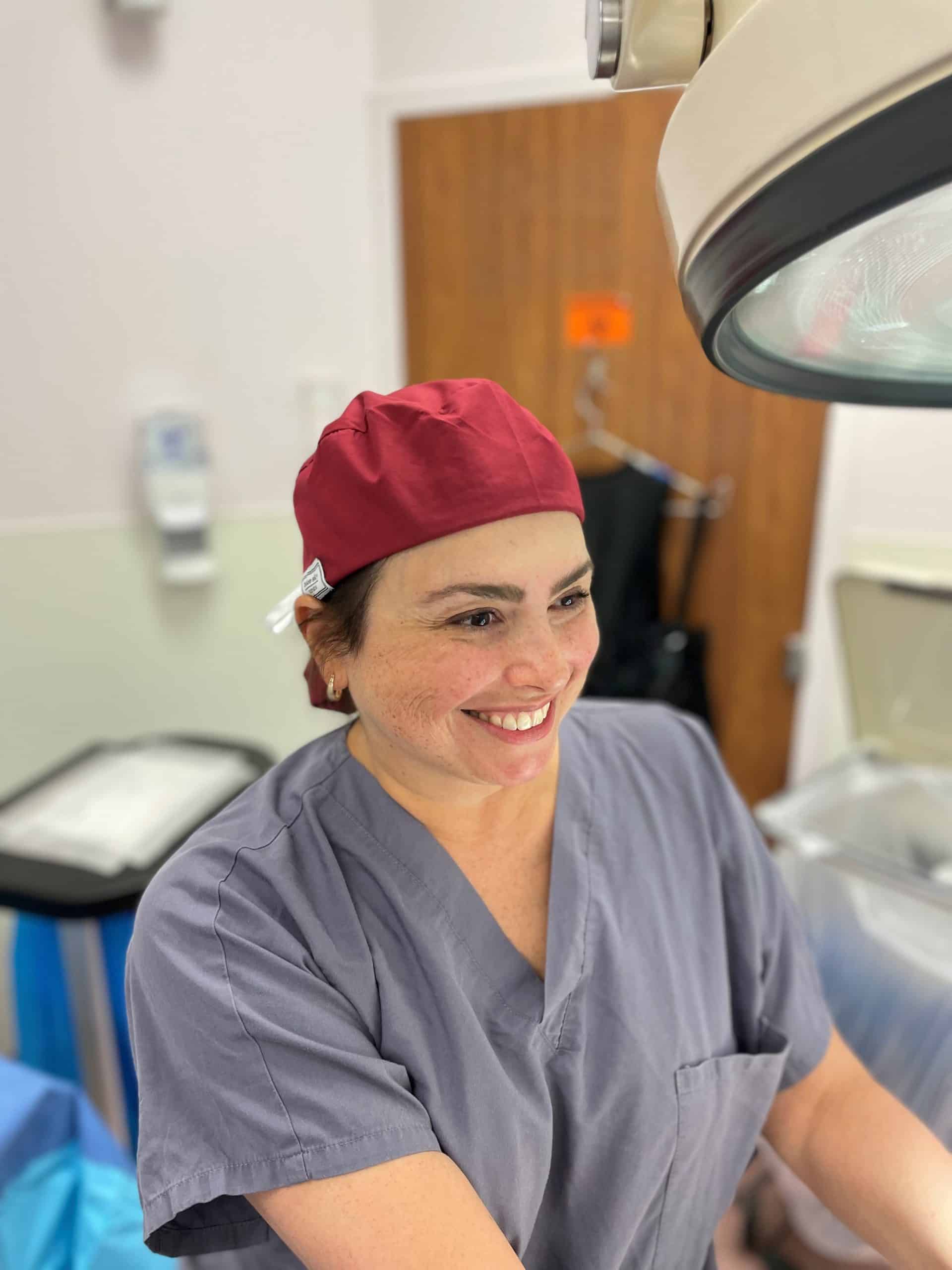
African American men are more likely to develop prostate cancer and twice as likely to die from prostate cancer, as compared to non-Hispanic white men, according to the Office of Minority Health.
“This is likely due to genetics, lack of access to health care, general mistrust in health care and socioeconomic factors,” said Dr. Ames. “Those men with a family history of prostate cancer and men over the age of 65 who take one or two medications and are overall healthy, need a PSA screening every year.”
The screening process may look a bit different from what many may have experienced before. Dr. Ames, along with many other urologists, now do the blood PSA screening as the first line of screening. These providers will do a physical exam after the PSA screening indicates cause for concern. According to Dr. Ames, this method has brought in many more men for prostate screenings that may have not gotten one before due to anxiety or hesitancy of the physical exam. Men are encouraged to talk to their provider about the screening process.
“If you are diagnosed with prostate cancer, we will look at all of the treatment options available,” said Dr. Ames. “While some with low-risk disease may not need aggressive treatment, there are options available such as hormone therapy, radiation or prostate removal.”
The best treatment is prevention. Eating a healthy diet high in fruits and vegetables and low in processed foods and red meat can help reduce your risk of prostate cancer, along with quitting smoking.
“Obesity and smoking are two of the leading causes of prostate cancer,” said Dr. Ames. “Once you have been diagnosed and treated for prostate cancer, obesity increases the risk for the cancer coming back in the future.”
During the COVID-19 pandemic, screenings across the board significantly lowered. This is a significant concern amongst medical experts.
“Many people postponed their cancer screenings, and we are very concerned about that,” said Dr. Ames. “This increases the chance for a larger number of patients to be diagnosed with advanced or later stage cancers, including prostate cancer.”
The bottom line?
“You need to return to your cancer screenings, whether it be prostate, breast, lung or colon cancer screenings, especially if you skipped them during COVID-19,” Dr. Ames said. “Early detection can save lives.”
Resources
While skin cancer is less common in African Americans, experts say death rates from melanoma are much higher in the African American community. Melanoma, which often presents as an irregular mole, can spread much quicker and easier than most other skin cancers and can produce worse outcomes. Melanoma is often found in later stages in African Americans when treatment can require more intensive surgery or even radiation or chemotherapy. Knowing the signs and symptoms can help catch melanoma early, when the cancer can be cured.
African Americans are up to four times more likely to be diagnosed with advanced melanoma and 1.5 times more likely to die from melanoma, according to the Melanoma Research Alliance. This is alarming, considering African Americans account for a small portion of melanoma diagnoses.
Skin cancer is the most common type of cancer. The three major types of skin cancer are basal cell carcinoma, squamous cell carcinoma and melanoma. Basal cell carcinoma and squamous cell carcinoma can present as pink or scaly lesions that are not healing or spots that are bleeding, itchy or painful. These forms of cancer are largely treatable and less severe than melanoma, which presents as an irregular mole.
UV rays from the sun and tanning beds are responsible for most cases of skin cancer. While sun exposure from UV rays may contribute to some degree of skin cancer in African Americans, the genetic makeup plays the largest part in melanoma diagnoses.
“Melanoma shows up in areas that typically are not exposed to the sun, like the toes, tips of the finger or under fingernails and toenails,” said Dr. Tiffany Alexander, dermatologist, ECU Health. “When identified and treated early, most melanoma cases are curable.”
However, melanoma can spread quickly into the blood and to other organs if not found early, and can even be deadly. Knowing that African Americans are more likely to be impacted by advanced melanoma, Dr. Alexander recommends learning the signs and symptoms and taking early action to detect and treat melanoma in its earliest stages.
“African Americans typically present in a more advanced stage because there is not a lot of awareness of melanoma occurring in African Americans, and the perceived risk of melanoma among African Americans is typically low,” said Dr. Alexander. “Many people also neglect to check areas that are not typically exposed to the sun frequently.”
Completing regular self-exams of areas both exposed to the sun and areas not exposed, like fingers and toes can help catch irregularities early. The ABCDEs of melanoma can help in identifying odd or suspicious moles that may need a second look by a dermatologist.
- A: Asymmetric, irregular shape
- B: Borders that are irregular and not round
- C: Color – a mole that is differently colored than other moles
- D: Diameter more than 6 mm in size
- E: Evolving, growing rapidly, a mole that becomes symptomatic
One of the most common misconceptions is that people with darker skin do not get sunburned, according to Dr. Alexander.
“A common myth I hear from my patients is that people with darker skin do not get sunburned,” said Dr. Alexander. “While those with more melanin in their skin have more protection against the sun, I encourage everyone to wear sunscreen with a minimum 30 SPF, no matter skin color.”
Most importantly, Dr. Alexander says, pay attention to your body.
“Get out of the sun if you feel yourself burning,” said Dr. Alexander. “If there is a mole that fits in the ABCDEs of melanoma or a lesion that is not healing or spots that are bleeding, itchy or painful, see a dermatologist.”
Dermatologists provide professional and thorough skin checks and can identify potentially cancerous areas early, when treatment options are great and the cancer is curable. To find a dermatologist near you, please visit ECUHealth.org/dermatology.
The Brody School of Medicine at East Carolina University has experienced recent success in recruiting a diverse group of patients to participate in clinical trials for new medications and treatments.
Data shows that from March 2019 to March 2020, 202 patients participated in oncology clinical trials in ECU’s Division of Hematology and Oncology; 50 percent of them represented races other than white. The following year, 419 participants were accrued, and 56 percent represented races other than white. That year, 50 percent of clinical trials participants were Black or African American.
“Our patient population, as well as Brody’s mission, has led to our success,” said Susan Eubanks, clinical trials nurse specialist in Brody’s Division of Hematology and Oncology. “Part of our core values is to cultivate a clinical environment of robust learning, innovation and discovery. There have been trials with participants here in eastern North Carolina that have led to new treatments in diseases and in some cases where there were few options.”
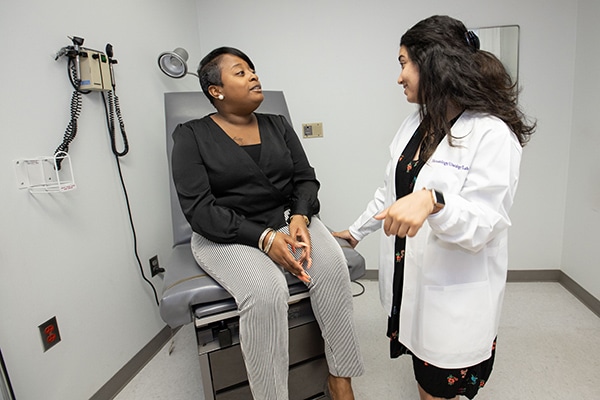
Now, researchers and providers hope to build on that momentum for future clinical trials studies.
Providers and researchers in the school continue to seek minority participants in clinical trials for new and potential pharmaceuticals — and to collect invaluable information on how some treatments impact patients of various races.
Doctors want to ensure that the drugs they are studying match the demographics for all the patients who could rely on those medicines in the future — by including people from a wide variety of backgrounds and races in the studies.
“We all agree that as much as possible, the drugs we give should be approved through clinical trials that match the demographics they will be prescribed to,” Eubanks said. “There has been chemotherapy that has shown promising results in one country but doesn’t carry the day in another. So, overcoming this disparity — whatever the cause — is essential.”
One of the latest innovations in oncology is the use of immunotherapy, the treatment of disease by activating or suppressing the immune system. Data that reviewed participation in those trials showed that less than 4 percent of participants in key immune therapy trials were African American.
“This is a problem,” Eubanks said. “Given the low representation we can’t predict if there will be a differences in outcomes related to differences in response from tumor biology. It is not highly understood why we see differences in drug efficacy and toxicities among different ethnicities, but it drives the point home, we need to do all we can to include the best representation of our population when bring new therapies to market.”
Dr. Darla Liles, professor and division chief of ECU’s Division of Hematology and Oncology, said diseases like prostate cancer and colorectal carcinoma see more African Americans impacted than other races, and the diseases begin earlier in those patients as well.
“Also, the distribution of the DNA mutations are different across races,” she said. “We might have a drug that works wonderfully well in Caucasians but not so well in African Americans or Hispanic individuals because of these different DNA changes. But we only know that if enough minorities participate.”
Recruiting challenges
Even with the critical need for data that better illustrates potential patient outcomes, recruiting minority participants in clinical trials can be difficult.
“Accruing to clinical trials in general is difficult, but minorities are typically underrepresented in clinical trials,” Eubanks said. “This can be an access issue, a reluctance issue and, at times, both.”
There can be many reasons recruiting minority participants to clinical trials can be a challenge, Liles said, but keeping those reasons in mind and understanding that they vary from person to person help build trust.
Brody’s mission draws heavily on a theme of access for all: to a medical education, to health care, and to resources that can sustain health and wellness. That’s one reason access to clinical trials in the medical school is vital to the study and approval of novel treatments.
“Part of our commitment to the health care of all eastern North Carolinians is ensuring the pharmaceuticals and treatments that we study are safe and effective for every patient who may need them in the future,” said Dr. Michael Waldrum, Brody’s dean and CEO of ECU Health. “Our efforts to widen the participant base in our clinical trials programs reflects the importance of thorough and inclusive studies that yield results that we are confident meet our mission.”
Liles said that people are more likely to trust providers and those running clinical trials if they feel they share common bonds with them.
“Several times when I presented a trial to a patient, afterwards the CRA has told me that they went to high school with the patient or knew them from church,” she said. “Being able to relate to the people who are treating you is essential.”
Education is key as well, Liles said.
“When I offer a trial to a patient, I often understand this is starting a conversation over several visits to ensure patients know about and understand what they are signing up for,” she said. “The consent forms for clinical trials are jam-packed with important information about the treatments, and sometimes people use that as a starting point for knowing what to ask about their treatment. I never regret giving a patient a consent form and talking to them about a trial. Even if they eventually decide not to do it ,they are better informed by participating in the process.”
Eubanks said the COVID-19 pandemic and reluctance by some to take the vaccine are a reminder of how to approach building trust in clinical trials.
“We must think beyond just education in the office,” she said. “We must reach people where they are.”
One way Brody is working to reach many different patients is having trials open for a variety of specialty care areas.
“The biggest step is understanding your population and having trials open for the specialty areas you see,” Eubanks said. “Brody has trials open with many specialties. In adult hematology/oncology we use databases and the tumor registry when approached about upcoming trials to help us determine if a trial is potentially feasible in our area. We also have the benefit of having local resources such are the University and Medical Center Institutional Review Board (UMCIRB) and leaders such as our associate dean for research and graduate studies, Dr. Russ Price, that provide expertise and infrastructure needed to offer clinical trials.”
Liles uses word of mouth to share clinical trial opportunities to patients.
“I often tell my patients about new and innovative trials that are on the horizon, even if they do not fit the criteria for the trial,” she said. “I think it is important for patients to understand that there are new things being developed all the time. Education is our best way to ensure patients know about and participate in trials.”
Liles also believes the combination of specialties and resources in the creation of the ECU Health brand will have a positive impact on the clinical trials program. With close to 1.4 million people in the system’s service area, there is promising potential to reach people through improved infrastructure for research opportunities.
Read more from ECU News Services.
Regardless of the world around us, cancer does not pause for anything. Colorectal cancer screenings have severely decreased during the COVID-19 pandemic, and doctors are worried this will lead to more cases of advanced stages of colorectal cancer.
In general, colorectal cancer starts as an overgrowth of the tissue in the colon, called a polyp. There are different types of polyps, some of which change into cancers in the future.
“We want to find out about colorectal cancer before there are any signs or symptoms,” said Dr. Warqaa Akram, colorectal cancer surgeon for ECU and Vidant Health. “We want to catch it when a person is healthy because colorectal cancer is very treatable when caught early. Some polyps are small and won’t give you many symptoms, if at all, when it starts.”
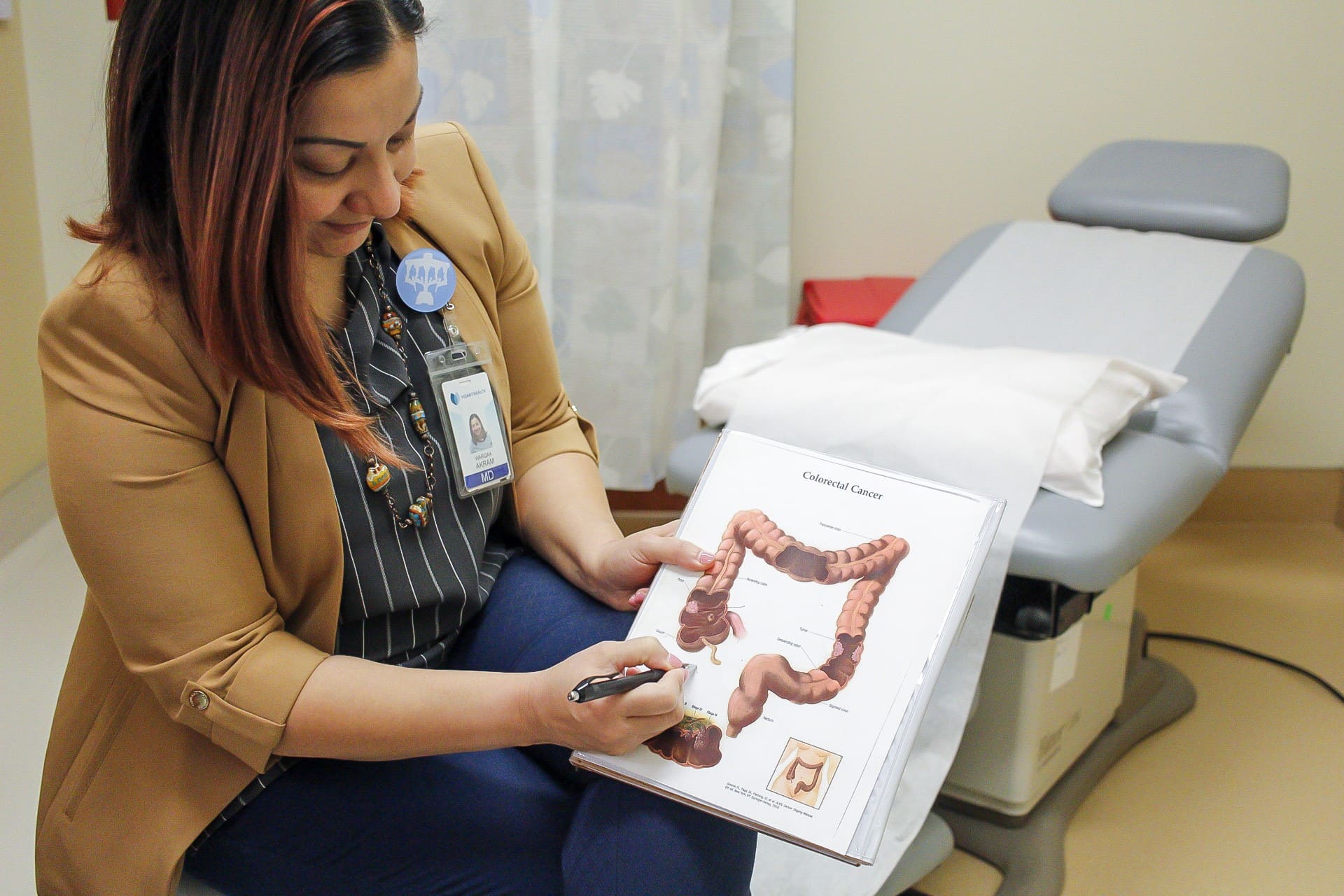
Providers aim to find polyps and remove them before they progress into cancer. More advanced tumors can cause bleeding and obstructions. That’s why doctors are recommending screenings five years earlier, at age 45. However, that age may be lower for those who are high-risk, meaning they have a close relative such as a parent or sibling who has been diagnosed with colorectal cancer.
“If you have a family history of cancer, we begin screenings at age 40 or 10 years before the diagnosis of a family member, whichever comes first,” said Dr. Akram. “For example, if the father was diagnosed at age 45 with colorectal cancer, children should begin screenings at age 35. If a father was diagnosed at age 60, children should begin screenings at age 40.”
Overall, the instance of colorectal cancer is decreasing, likely due in part to screenings. However, the incidence of colorectal cancer in younger people is on the rise. Although the reasons are not completely known, an increase of processed foods, poor diet and lack of exercise are all contributing factors. While the causes of colorectal cancer are unknown, and some are unmodifiable like genetics, some of the largest contributing factors are eating a diet high in processed foods and red meat. Experts encourage a high-fiber diet to help prevent cancerous polyps.
It is important to note that colorectal cancer disproportionately affects Black Americans more than any other race in the country. In eastern North Carolina, the incidence of cancer is 20 percent higher in African Americans than any other race, and the risk of death is higher by about 40 percent. Socioeconomic status and lack of access to health care are some of the reasons incidences in colorectal cancer are higher in the African American population.
“Knowing that younger people and the African American population are having higher incidences of colorectal cancer, it is very important to get regular screenings,” said Dr. Akram. “We know a lot about colorectal cancer, and it is a type of cancer we know how to treat and we know how to defeat. The earlier we catch colorectal cancer, the better the results and possibility of being cured.”
During the COVID-19 pandemic, colonoscopies decreased by 90 percent at Vidant Health.
“This is very alarming because incidences of more advanced colorectal cancer could be in our future in eastern North Carolina,” said Dr. Akram. “We are learning about less incidences of cancer and risking that people will present with more advanced stages of cancer.”
“I know no one wants to hear a cancer diagnosis, but thanks to early detection through screenings, colorectal is mostly preventable, treatable and often curable,” said Dr. Akram. “Colorectal cancer does not have to be a death sentence.”
For more information about the risks, prevention and screening resources for colorectal cancer, or if you do not have a primary care provider, please contact the Prevention Clinic at ECU Health Cancer Care at (252) 816-7475.
Vidant Beaufort Hospital, a Campus of ECU Health Medical Center and ECU Health Women’s Care, located in Washington, offered free breast cancer screenings on Friday, Feb. 25 for uninsured women 40 years of age and older with at least one year since their last mammogram.
“Some of these patients have never had mammograms before, and some of them haven’t had one in many years,” said Caddie Cowin, DNP, FNP-C at ECU Health Women’s Care – Washington. “All of these patients are either uninsured, or their insurance does not cover breast cancer screenings.”

Patients received a clinical breast exam, mammogram and education on signs and symptoms of breast cancer to watch for. Mammograms are one of the greatest tools to screen for breast cancer, and early detection is proven to save lives. Even with monthly physical exams at home, mammograms can catch warning signs that go undetected. Yearly mammograms are recommended to begin at age 40, or age 35 if you have close family history of breast cancer. Breast cancer can be treated with better outcomes if caught early.
According to the Department of Minority Health, Black women were just as likely to be diagnosed with breast cancer, however, they were almost 40 percent more likely to die from breast cancer, as compared to non-Hispanic white women from 2014-18. An explanation for that gap, according to the 2020 census, could be health insurance. The percentage of the Black population with no health insurance coverage for the entire calendar year was higher than for non-Hispanic Whites, at 9.6% compared to 5.2%, according to the 2020 census. Bridging the health care gap to provide early clinical interventions is important in eastern North Carolina, where Vidant and the future Vidant Health serves a large, diverse region.
“The biggest challenge is access to care,” said Cowin. “We know that patients with a lower socioeconomic status struggle more with access to health care and insurance. The disparity is challenging, but this program can help address the need. Just because they cannot pay out of pocket doesn’t mean they can’t get as good care as anyone else.”
“The last clinic we did, a couple of patients ended up needing biopsies, so we were able to catch potentially dangerous things early,” said Cowin. “We could save somebody’s life with what we are doing.”
If a patient does have abnormal findings, the Breast and Cervical Cancer Control Program (BCCCP) from the county health department funds follow-up appointments and connects women to treatment if diagnosed. BCCCP is designed to help uninsured or under-insured women pay for mammograms and pap smears, according to Sherri Griffin, RN, BCCCP nurse navigator, Beaufort County Health Department.
“If we do have any ladies unfortunately diagnosed with breast cancer, we help them apply for breast and cervical cancer Medicaid, which pays for their treatment,” said Griffin. “The women that we have treated today are in a gap where most cannot qualify for Medicaid but cannot afford health insurance. They typically put off health screenings because they have to pay out of pocket. At this event, we fill in gaps for the women who may need additional imaging after the initial screenings.”
Screenings at this event were funded by the Shepard Cancer Foundation and Vidant Health. For more information on cancer screenings, please visit VidantHealth.com/Cancer. More information about BCCCP can be found at BCHD.net.
Read more in The Washington Daily News.
March is Colorectal Cancer Awareness Month and there is no better time to ensure you are keeping up with recommended screenings. One of the best ways to take care of yourself is by taking preventative steps with your physical health and well-being through regular visits to your health care provider.
Early detection and prevention can be life-saving for certain types of cancers, including colorectal cancer. Here in the east, ECU Health Cancer Care (VCC) is a leading provider in colonoscopy and colorectal cancer care and screening.

With colorectal cancer being the third most common cancer in the United States, one of the most important and preventative measures you can take for early detection of colorectal cancer is to be regularly screened. Many people do not experience symptoms in the early stages of colon cancer, so it is especially important to get regular preventative screenings. Screenings can be done in a variety of ways, some of which include colonoscopies and fecal testing. Early detection and prevention means that if cancer is detected, treatments can begin earlier.
Regular screenings for colorectal cancer are recommended to begin at age 45. If you’re eligible for a screening and do not have one scheduled, take the opportunity during Colorectal Cancer Awareness Month to talk to your primary care provider, obstetrician-gynecologist, or gastroenterologist about scheduling the procedure.
Vidant Health also hosts events, including screenings, across the East. The Vidant Oncology Outreach can also be contacted at 252-847-9507 for more information on screenings and events in your area.
Learn more about ECU Health Cancer Care’s services and how to connect with us on the Cancer section of VidantHealth.com
